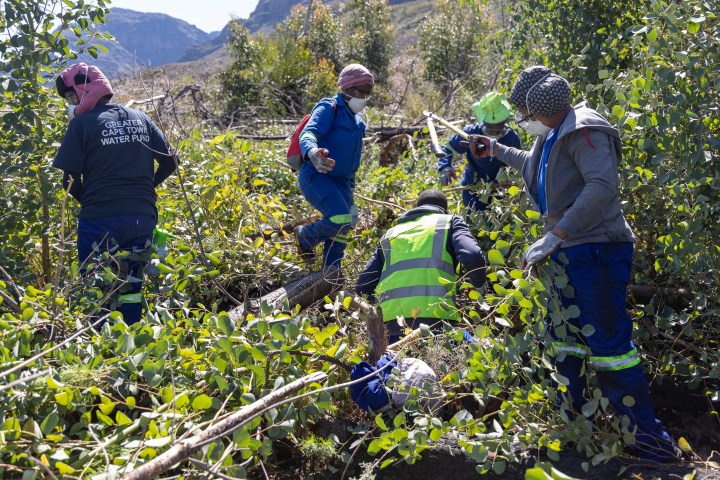GROUNDUP WATER CRISIS
Cape Town ploughs millions into clearing of invasive plants

The project is expected to save billions of litres of water a year.
Thirsty alien plants such as pine and eucalyptus trees are being cleared from mountain catchment areas across Cape Town. These plants drain billions of litres of water.
The City of Cape Town partnered with The Nature Conservancy (TNC) in July 2021 and committed to a two-year contract for R50-million to clear invasive species around important catchment areas such as Wemmershoek, Steenbras, Berg River, and Theewaterskloof. So far 4,617 hectares have been cleared. Another 7,000 hectares will be cleared over the next year. About 1,088 jobs have been created through the project.
The City, in a recent statement, said clearing invasive plants will, in a few years, result in savings of billions of litres of water per year.
Research from 2018 by the Greater Cape Town Water Fund (GCTWF) found that invasive species around these catchment areas contribute to significant water losses. It recommended that they be cleared as a sustainable and cost-effective way to reduce Cape Town’s water losses. According to its study, without intervention, the 55-billion litres of water sucked up by invasive trees could more than double in the next 30 years.
It noted that initial control operations would cost up to R40,000 per hectare “in very dense invasions in rugged terrain and riparian areas”. After this, the cost should decline as plant density and size decreases.
Jasper Slingsby, of the Department of Biological Science at UCT, wrote in 2018 that invasive alien species were a greater threat to Cape Town’s water supply than climate change.
Visit Daily Maverick’s home page for more news, analysis and investigations
Speaking to GroundUp recently, Slingsby said the City’s project is “a good start” but “inadequate to get the job done”.
“If we actually want to fix this problem, we probably need about five times the investment to get it done, if not more,” he said.
The study by the GCTWF estimated that about R370-million is needed for catchment restoration to generate water gains of 50 billion litres a year. The City’s R50-million investment in the project is not enough, said Slingsby.
GroundUp joined the City and TNC at the Wemmershoek catchment to see the process.
Removing trees and plants in mountainous areas can be tricky. Richard Bugan, monitoring and evaluation manager at TNC, said that three teams are contracted to help clear invasive plants. Each team does manual clearing using chainsaws, loppers, and saws to cut down and remove the invasive trees.
The first team works in lower-lying areas; the second camps in remote areas; the third team operates on cliff faces.
This year we’ve had below-average rainfall. “If we have another bad year in 2023, we’re going to be straight back in the same boat [Day Zero] again,” said Slingsby. DM
First published by GroundUp.





















 Become an Insider
Become an Insider
instead of draining the Boland of trillions of liters of water, defecating in it and sending it out to sea virtually untreated, it would be a nice touch if CPT would treat its effluent and return it to streams and lakes and dams. But yes, getting rid of aliens helps.
The City is right – but clearing is ineffective in the long term unless thorough, and followed up ad infinitum. It is also absolutely essential that manual clearing be supported by a comprehensive bio-control programme. This has helped in the control of hakea, long-leaf wattle, and now we even have an introduced midge that is limiting the flowering and seeding of black wattle – but MUCH more most be done if this battle is to be won. Individual land-holders must also be encouraged to play their role, and not leave it all to “the authorities”.
Unless the invasive tree roots are either removed entirely, or poisoned, this is a futile exercise as they will simply grow again. I did see some (blue) poison being applied to some stumps, and one small tree being pulled up by the roots in the video.
Unless they are being meticulous about it, the problem is simply being deferred, and not solved.